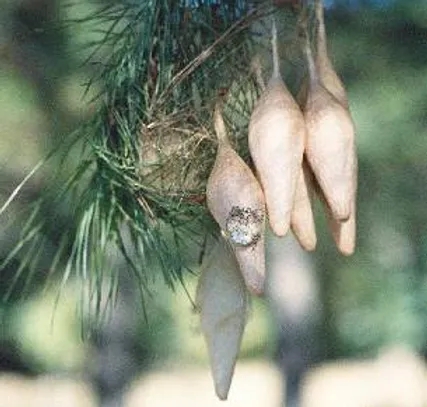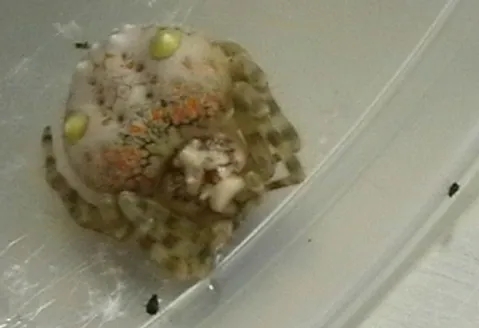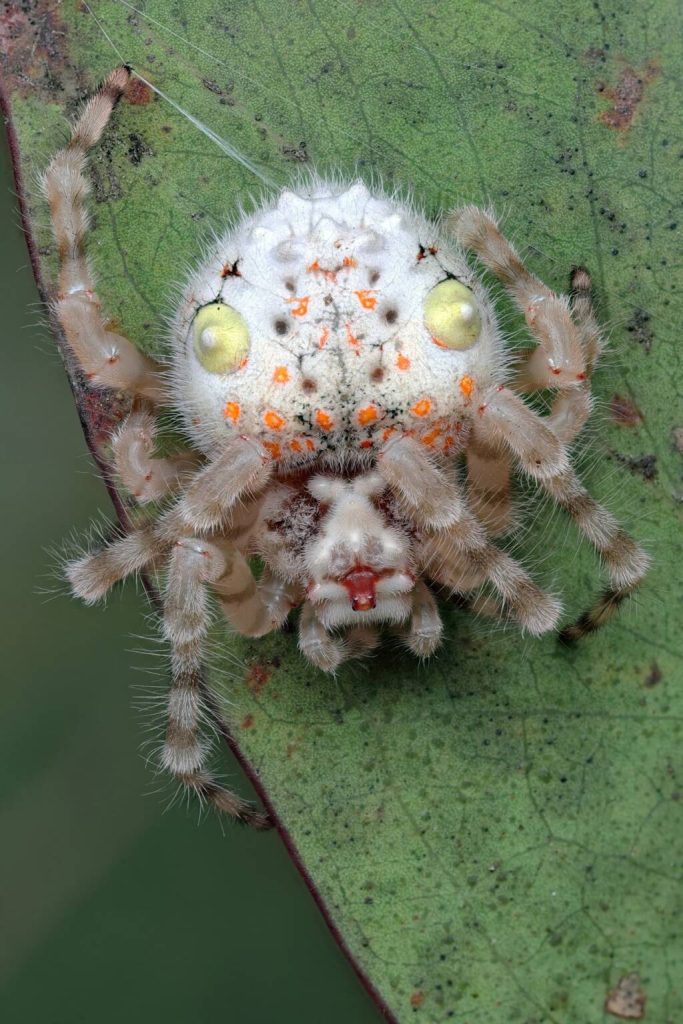

There are at least 2 species of Magnificent spider. The Bolas spider is one of them. The female is 12mm long while the male is 2mm. The Magnificent spider is known also as the Angler spider.
This spider is part of a family (the Mastophoreae) within the orb-weaving spider family (Araneidae) that no longer build an orb web, but instead attract their prey of male moths by chemical mimicry.
Habitat:The Odgarius Magnificus is found in N.S.W., Qld, Tasmania, South Australia and Victoria. At daytime, it retreats to a home made of leaves bound together with silk. They live in the foliage of native trees and shrubs such as eucalyptus, which are usually a few metres from the ground. The Magnificent spider has adapted well to urban situations.
They live in trees or tall shrubs, rarely less than 2 m above the ground. The easiest way to find them is to search for clusters of large, brown egg-sacs suspended among foliage; the spider will be found nearby, at day sheltering in a retreat made from rolled leaves and silk.
Like all bolas spiders, the female attracts male moths with an airborne pheromone. Once a moth approaches, the spider senses it coming due to vibration sensitive hairs on its outstretched legs. It is then caught with a sticky globule that is swung at the prey.
The egg-sacs are up to 5 cm long; one spider produces up to nine sacs per season, each with several hundred eggs.
Appearance: The female measures up to 14mm long (25mm when pregnant) and the male is hardly able to be seen at a mere 1.5-2mm. The species is basically white, except for its abdomen which has two small, bright nodules and numerous tiny salmon coloured star-shaped patterns. The body and limbs are covered with lots of fine hairs that are particularly long on its forelegs.
Prey:The female Magnificent Spider has a special scent to attract male moths. Once the Moth is within “fishing range” it throws the sticky thread. The bolas is a sticky ball of glue and silk attached to the end of the silk thread.
Breeding: The Magnificent spider produces about 6-7 long papery egg sacs. The egg sacs will always be near the female. These take around 3 months to hatch. When they hatch, the female never leaves her young alone. Even at hunting time.
Appearance
The female Magnificent spider has the following identifying characteristics:
- Creamy white body and legs that are covered in long fine hairs
- Two bright yellow knobs on its abdomen, and a series of salmon-coloured spots and blotches
- Size ranging from 14 mm – 25 mm

Feeding and behaviours
Like other bolas spiders, the Magnificent spider uses deception to capture its preferred prey – moths.
At night, the Magnificent spider spins a short line of silk with a sticky globule, or bolas, at the free end.
This globule may emit an airborne pheromone that imitates the scent of female moths belonging to the Noctuidae family, thereby attracting male moths of the same genealogy.
The Magnificent spider has vibration sensitive hairs on its legs. As such, when it senses the approach of a moth in flight, it twirls the silken thread and swings the globule around until it hits the moth.
It then hauls the moth up and bites and immobilises it, either to eat it immediately or stow it away for safekeeping.
Female Magnificent spiders also use their spinnerets to construct brown, spindle shaped egg sacs that can be up to 5 cm long and house roughly 600 eggs.
Danger to humans
The Magnificent spider is not considered dangerous to humans. However, if you are bitten by one, it is better to be safe than sorry and follow the first aid procedure for a Redback spider bite.
The female Magnificent Spider is about two cm long whilst the tiny male is only 1.5 millimetres in length. The female has very distinctive markings with two bright yellow knobs on her white abdomen. There are also salmon-coloured spots and blotches on her body. Fine, long hairs cover legs and body.

The Bolas Spider using a cunning method to capture prey. At night the female spins a line of silk with a sticky globule on the end. The Bolas name refers to the South American throwing weapon made of ropes and weights. It is thought that the sticky globule may contain a pheromone mimicking the scent of female moths, attracting unwary male moths. The spider twirls the thread when it senses the moth’s beating wings. The moth becomes stuck to the globule when close enough. Prey is eaten immediately or stored for later wrapped in silk. Spiders may respond to vibrating guitar or other instrument strings.

Magnificent Spiders hide during the day in a retreat of leaves bound together with silk.
Little is known about their courtship and mating. When egg development starts, the female’s abdomen swells massively. Over several nights distinctive spindle-shaped egg sacs are constructed. Each sac contains about 600 eggs. Up to seven sacs are attached to a branch. The photo shows six egg sacs. When the baby spiders emerge, in late winter and early spring, they disperse by spinning a thread and being carried away by the wind.
There are three Australian species and are found in New South Wales and Queensland.
We first found the egg sacs in January. They were somewhat weather-beaten, but still recognizable in October of the same year.
Bolas Spiders pose no threat to humans.
